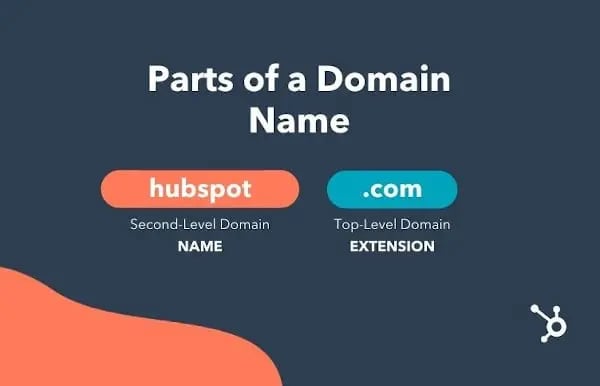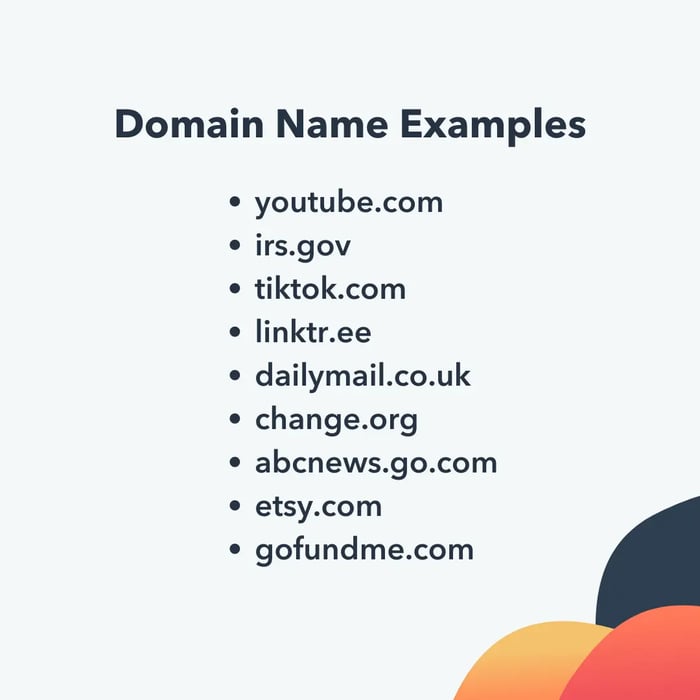Securing a domain or domain name is the first step in creating an online presence that will help you get found by prospects on Google and other search engines.

In this post, we'll cover everything you need to know about these terms so you can continue the process of setting up a website for your business. You can skip ahead to any of the sections below:
- what a domain is
- what domains are used for
- what a domain name is (and what parts it's made up of)
- types of domains
What Is a Domain?
A domain is a part of the web address nomenclature someone would use to find your website or a page of your website online. It is a string of text associated with the numerical IP address of a website that's much easier for people to remember and search.

How to Launch a WordPress Website
Learn how to launch a website on WordPress with this step-by-step guide and checklist. Learn how to...
- Set up your domain name.
- Install an SSL certificate.
- Analyze your content.
- Back up your site.
Every website has an IP address, which is a unique string of numbers that connect computers to web servers. IP addresses are great for computers, but difficult for people to memorize. That's where domains come in. A domain name is connected to a website's IP address so people can more easily remember and search for a website by its domain and their browser can still find the specific web server that hosts the website via the associated IP address.
A domain is often compared to a home address. Your friends don't memorize your house's GSP coordinates every time they want to visit you. Instead, they just plug in your street address into their phones. The same goes for visiting a website. Instead of memorizing a website's IP address, visitors simply type in the domain into their browser.
What does a domain look like?
A domain typically consists of two or three words separated by dots. For example, blog.hubspot.com is a domain.

A domain is one part of a complete web address, or URL. A URL typically consists of a protocol, domain name, and path. For example, the URL of this blog post is: https://blog.hubspot.com/service/what-is-a-domain. It's made up of the following parts:
- protocol ("https://")
- domain name ("blog.hubspot.com")
- subdomain ("blog.")
- second-level domain ("hubspot")
- top-level domain (".com")
- subdirectory ("/website/")
- path ("/what-is-a-domain")

We'll cover the parts of a domain name in more detail below. First, let's cover why domains are important.
What are domains used for?
Domains are not only used to simplify how visitors find your website. Below we’ll look at several other reasons domains are used.
1. To Gain Ownership
Perhaps most importantly, a domain gives you ownership over your website's address. No one else can claim it while you have it registered. This grants you total control over what website it points to, which domain name registrar maintains it, what information is associated with your domain name account, who administers it, and whether you want to sell it.
2. To Solidify Your Brand Identity
A domain name that matches or resembles your company name can help you establish a consistent online brand identity. A visitor moving from your website’s homepage to blog to knowledge base, for example, will notice that the core domain name remains consistent, as do other elements like the color scheme and typography.
3. To Establish Credibility
A domain name that aligns with your company name establishes credibility, and makes your website appear more legitimate and professional to users. That builds trust with your visitors so they feel comfortable taking actions, like submitting a survey or form on a web page with that same domain name.
Some website builders will provide a templated subdomain to free users, such as accountname.wixsite.com/address. However, a custom website complete with a custom domain name such as accountname.com may seem more credible and professional to incoming visitors!
4. To Be Memorable
If your domain is easy to remember, visitors can easily enter it into their search bars. This may result in more direct traffic to your site. For example, T-Bones Great American Eatery has a short and sweet domain name: t-bones.com. This is much easier to remember than an alternative like t-bonesgreatamericaneatery.com.
5. To Stand Out Against Competitors
A simple but catchy domain name can set you apart from competing sites with clunkier or confusing domains. For example, if Google had been named BackRub, it might not have competed as well with Yahoo and other search engines.
6. To Build Authority
In addition to strengthening your brand, domain names can also help you predict how likely your website will appear in the SERPs compared to your competitors. As a rule of thumb, the older a domain is, the more authority it has. That’s because it’s had time to accumulate quality content, internal links, and backlinks.
What is a domain name?
A domain name is the unique name of a website. It functions like the site's home address on the World Wide Web.
The term “domain name” is used interchangeably with the term "domain." The only difference is that one is the name of the thing and one is the thing itself.
Not including its extension, like “.com”, the maximum length a domain name can be is 63 characters. The minimum length can be one character.
For a quick overview of what a domain name is and what it's made of, check out this video by Elegant Themes. Then continue on to learn about domain names in more detail.
The Parts of a Domain Name
There are typically two parts of a domain: the second-level domain and the top-level domain. If read left-to-right, these parts decrease in specificity.

Second-Level Domain (SLD)
The second-level domain is the unique identifier for your website. It's the part of your domain that comes before “.com” or another extension.
If you're building a website for your business, consider buying a domain that reflects your business's name. This will make it easier for people to find your website without needing to spend a lot of time scouring Google for it. For instance, hubspot.com’s second-level domain is “hubspot”.

How to Launch a WordPress Website
Learn how to launch a website on WordPress with this step-by-step guide and checklist. Learn how to...
- Set up your domain name.
- Install an SSL certificate.
- Analyze your content.
- Back up your site.
Top-Level Domain (TLD)
The top-level domain is the extension, or the part of your domain that comes after your second-level domain.
It specifies what type of entity your organization registers as on the internet. For example, HubSpot’s top-level domain is “.com” since we’re a commercial entity in the United States.
Most American businesses also register their website with “.com”. In fact, according to data from Verisign, the largest TLD in 2021 was .com, with 158.6 million reported domain names in the domain name base.
What is a domain name example?
An example of a domain name is usps.com. This is made up of a second-level domain ("usps") and top-level domain (".com). It is one of the most visited government domain names, according to Statista.
Other examples of popular domain names are "youtube.com", "irs.gov", and "tiktok.com". Check out more in the list below:

These are just a few domain name examples — there are literally millions more. According to data from Verisign, there were over 360 million registered domain names at the end of 2021.
To get a better idea of possible domain names, let's look at different types of domains below.
Types of Domain
- Generic Top-Level Domains (gTLD)
- Country Code Top-Level Domains (ccTLD)
- Internationalized Country Code Top-Level Domains (IDN ccTLD)
- Subdomain
Generic Top-Level Domains (gTLD)
gTLD refers to the best known and most broadly used TLDS:
- .com
- .net
- .biz
- .org
- .info
.com is the most popular by far. As of January 2022, 54% of global websites used a .com top-level domain. The next most popular — .ru — is only used by 5%.
Country Code Top-Level Domains (ccTLD)
These two-letter TLDs refer to specific geographical locations. Here are the most common ones:
- .cn (China)
- .ru (Russia)
- .de (Germany)
- .br (Brazil)
- .au (Australia)
- .uk (United Kingdom)
- .nl (Netherlands)
Internationalized Country Code Top-Level Domains (IDN ccTLD)
These are domains that can be displayed in non-Latin character sets (e.g. Chinese).
Subdomain
A subdomain is a domain that is part of a larger domain, appearing before the root domain name (e.g. blog.hubspot.com). Since a subdomain appears to the left of the SLD, it is also referred to as a third-level domain (3LD).
Another example of a domain name with a subdomain is tools.usps.com. It is made up of a subdomain ("tools."), a second-level domain ("usps"), and top-level domain (".com).
You may already be familiar with this domain name. In March 2022, it was the most popular government domain, getting over 244 million visits in 30 days according to Statista.
Now that you know what a domain is, you're ready to register one. Check out the step-by-step process in Everything You Need to Know about Custom Domains.
Pro Tip: CMS Hub users can add their custom domain to HubSpot for free. This allows you to connect your new domain to hosting, CDN, and security features all at one time.
Setting Up Your Domain
If you want to acquire a domain name, you must buy one and register it. To do this, visit a domain name registrar, like GoDaddy or Google Domains, plug your desired domain name in, check its availability and price, and then buy it, if it’s in your price range. From there, you'll be able to associate that domain with your server and hosting provider, making your site accessible via the web address.
Editor's note: This post was originally published in February 2019 and has been updated for comprehensiveness.






.webp)



